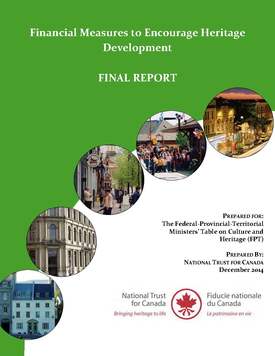
Release of ground-breaking new report: Financial Measures to Encourage Heritage Development
Heritage is in Demand! The National Trust envisions a future where the tangible benefits of heritage are recognized by society and seen as worth investing in.
A new report by the National Trust -- drawing on broad input from the heritage property development industry -- provides strong insights into the best potential financial measures to encourage heritage development in Canada. Commissioned by the Federal-Provincial-Territorial Ministers' Table on Culture and Heritage, the report draws on detailed input from 27 stakeholders from the heritage property development industry from 8 provinces. The report also identifies key factors that discourage heritage development. This is the first time that a pan-Canadian sampling of this type has been collected.
The report is accompanied by a concise Discussion Guide which details 14 financial measures for consideration and is supplemented by a Simulation Model to help stakeholders assess the potential revenue impacts of Income Tax Credit and Capital Cost Allowance measures.
Best Financial Measures:
- Ongoing Property Tax Relief (Provincial/Territorial)
- Heritage Grants (Federal)
- Refundable Income Tax Credit (Federal & Provincial/Territorial)
- Non-Refundable Income Tax Credit (Federal & Provincial/Territorial)
- Heritage Grants (Provincial/Territorial)
Key Heritage Development Disincentives:
- Low Return on Investment (ROI)
- Limits on Development Potential
- Complexity of Building Code Compliance
- The "Unexpected" in Heritage Projects
- Delayed Return on Investment (ROI)
Read the full report here.
Try out the Financial Measures Simulator or check out the Simulator Background and sample scenarios
|
|
DID YOU KNOW?
Victoria, BC's ten-year Tax Incentive Program has spurred the creation of 631 residential apartments in some 34 seismically upgraded and rehabilitated heritage buildings.
That it has attracted over $205 million in private investment to the downtown core that dramatically increased the value of the building and the city's property tax revenue.


